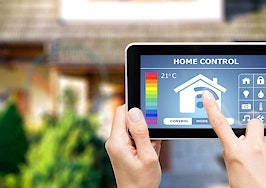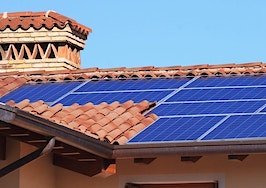This article is part of our ongoing series offering tips on how to sharped your skills this summer and use the season to your advantage. Read more in our Supercharge Your Summer section.
It’s summertime and your cooling costs are going through the roof.
Your electricity bill for June already hit $200, but your bedroom still feels 80 degrees hotter than your living room, and meanwhile your next-door neighbor casually mentions that her bill barely topped $50 for a house that’s practically the same size as yours. Is she secretly suffering the heat in silence or does she know something you don’t?
Well, take heart. The Jones’s may have a head start when it comes to energy efficiency, but keeping up with them isn’t so hard. For motivation, consider that the benefits of making key energy efficiency improvements include lowering your monthly bills, improving the comfort and healthfulness of your home, increasing the value of your home — and perhaps most valuable of all, building up your client relationships by sharing what you’ve learned.
Find your home energy efficiency wheel
Asa Fosso is the director of residential technology solutions at the U.S. Green Building Council (the folks behind LEED certification), and he tells Inman the technology and guidance on energy efficiency haven’t changed much in the past 15 years.
There’s EnergyStar for energy efficient appliances, WaterSense for water conserving fixtures (remember, water and energy are two sides of the same coin), and a vast array of reliable sources offer tried-and-true suggestions for warm weather energy savings online.
In other words, you don’t have to reinvent the wheel for home energy efficiency. However, you do have to find the wheel that fits your home.
Before you jump to the computer and start looking up tips and tricks, take a minute to assess your surroundings. For example, if you just moved into a new building, there’s a good chance most of the heavy lifting was already done for you.
That’s because many jurisdictions around the U.S. have upgraded their building codes significantly in the past 10 years or so, and especially within the past five years. Some builders also go above and beyond local requirements. If your energy bills seem unusually high, you may simply need to adjust your energy use habits.
Habits also loom large if you’re in a multi-family building or development with building restrictions, though you may have some wiggle room for new appliances and other minor upgrades.
It’s a different story for those of us living in the millions of older homes that pepper the US. Both opportunities for improvement and challenges abound, so let’s zero in on those first.
Air, air air
Before you run out to the appliance store to nail the latest EnergyStar fridge or spend thousands replacing all of your old windows, Fosso suggests that you start by air sealing. You’ll notice a big difference right off the bat.
“Air sealing is No. 1,” he said. “It’s not sexy because it’s behind the walls where you can’t see it, but it can reduce your bills by 10 percent to 30 percent. Air sealing also evens out the hot and cold spaces and reduces the temperature difference between upstairs and downstairs. Every house needs it, it’s an improvement, and it does not require behavior change.”
By air sealing, Fosso means targeting your attic and basement (between the basement ceiling and first floor) or crawlspace for insulation. According to Fosso, it’s a relatively low-cost job that a professional can do in one day, so you’re done and done. Retrofitting walls with new insulation is far more expensive and involved, so save that for when you’re feeling more ambitious.
If your roof is due — or overdue — for replacement this summer, get it done. Fosso suggests asking your contractor to use light-colored materials that deflect heat from the sun, instead of dark materials that absorb heat. Lighter roofing is another high-impact energy efficiency job that a team of professionals can pull off in a day or so, depending on the roof.
On the DIY side of things, fireplace flues (aka chimneys) can be a significant source of air leakage in older homes. The Department of Energy’s Office of Energy Efficiency and Renewable Energy offers this hot take: whenever your fireplace is not in use — which is all the time in summer — seal your drafty old flue with a removable balloon.
“A reasonably capable do-it-yourselfer can create an inexpensive, reusable fireplace flue plug by filling a plastic trash bag with fiberglass batt scraps and jamming it into the flue,” Fosso said. “Attach a durable cord with a tag that hangs down into the fireplace to remind you the flue is blocked and provide an easy plug removal method.”
The solar solution
One technology-based home energy solution that has undergone a sea change in recent years is the cost of rooftop solar installations. Regardless of whether or not your home is old or new, Fosso makes a good argument for installing rooftop solar now.
This is the biggest change in advice I’ve seen over the past 15 years,” Fosso said. “Solar has gotten so cheap that it’s one of the first things people should do. It’s also the only energy efficiency improvement that has a significant impact on sales value, because the panels are so obvious … It’s like free money.”
Don’t just take Fosso’s word for it. Lawrence Berkeley National Laboratory recently looked into the matter of sales value last year and found that “homebuyers are consistently willing to pay PV home premiums across various states, housing and PV markets, and home types; average premiums equate to approximately $4/watt or $15,000 for an average-sized 3.6-kilowatt PV system.”
Baby steps add up to big bucks
Speaking of unsexy solutions, Fosso emphasizes that technology can only go so far.
“Habits are equally important,” he said. “We’ve seen identical houses that vary energy use by a factor of four based on who’s occupying them. That’s an insane number.”
And, that’s where your neighbor comes back into the picture. Ask her how she keeps her bill so low. If she’s not just sweating it out, then maybe she uses her cell phone to remotely adjust her internet-enabled appliances for maximum savings, or maybe she simply turns off the lights whenever leaving a room, pulls her shades down in the morning and makes sure all the windows are shut before running the AC.
When you’ve figured it all out, you’ll have a cooler, more comfortable home and an array of first-hand advice to offer your clients, too.
That’s important because energy efficiency is going to come up no matter what the season.
Dorrie Love, an associate broker with Harry Norman Realtors in Peachtree City, Georgia, is the office’s No. 1 sales agent in five of the past six years. She told Inman that homebuyers seem to expect new construction to be energy efficient. The topic comes up often with resales, with the age and condition of the AC unit being a particular concern in the summer.
People also tend to ask questions about things they can see, like drafty windows or doors that need weatherstripping. Love is prepared with the answers.
“With my sellers, I make sure we discuss the basics,” Love said. “Weatherstripping around doors (including attic access), general maintenance on their HVAC systems, any leaking plumbing fixtures/faucets, etc. Another thing we may discuss is the possibility of the attic insulation needing additional insulation. That usually comes up in a buyer’s home inspection.”
That could partly explain Love’s success. She helps sellers anticipate questions and resolve problems before an inspection occurs, and the information can also help buyers focus in on negotiating points.









